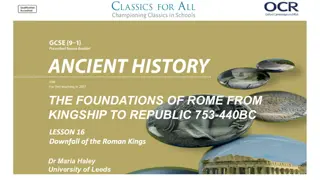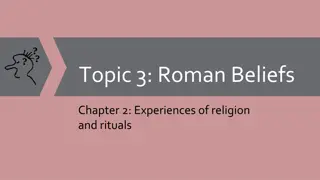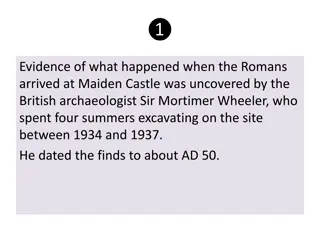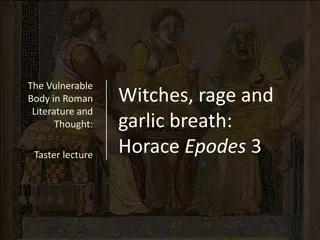The Roman Coliseum: Gladiatorial Fights and Public Entertainment
The Roman Coliseum, also known as the Flavian Amphitheatre in Rome, was used for gladiatorial fights and various public entertainment for over 500 years. Learn about the history, purpose, and life of gladiators in this iconic ancient arena.
Download Presentation

Please find below an Image/Link to download the presentation.
The content on the website is provided AS IS for your information and personal use only. It may not be sold, licensed, or shared on other websites without obtaining consent from the author. Download presentation by click this link. If you encounter any issues during the download, it is possible that the publisher has removed the file from their server.
E N D
Presentation Transcript
The Roman Coliseum A power point presentation made by Joey NiEdErLaNdEr
The Flavian Amphitheatre In the Center of Rome, Italy. Largest built in the Roman Empire emperor Vespasian started the construction between 70 and 72 AD , and ended under the power of Titus\ Domitian made modifications when he was in power. In Use for over 500 years
Why a Coliseum? 1. Gladitorial Fights- 2. Public shows and other 3. forms of entertainment-
Public Displays Mock sea fights Animal hunts Executions Reenactments Dramas based on Classical Mythology. Many other important uses
one of the most important things however, are the gladiatorial fights Wooden floors covered chambers below where the gladiators and animals were kept waiting to perform. Debate is still arise over if naval mock battle waters were kept below also. Remember in Mrs. Flanagan s class?
Life of a Gladiator Fought for entertainment- Most likely that the origin of the gladitorial fights was from the Estruscan custom of ritual human sacrifices to honor the dead. The first gladiatorial fight took place in 264 BC as part of one of these rituals called a munus. Marcus and Decimus Junius Brutus created a gladiatorial combat in honor of thier deceased father with three pairs of slaves as gladiators. The concept of the munus was that it kept alive the memory of an important individual after death. They were held some time after the funeral and were often repeated at annual or five- year intervals. Gladiatorial games, or munera were not a regular part of public games until the end of the first century.
Festus Festus suggested that gladitorial contests be used in place of the original sacrifice of prisoners.( Which they did on the tombs of great warriors).
____________________________ ____________________________ People who wanted political favor often would be there to host the shows. Who were Gladiators? Gladiators were usually slaves and criminals and war prisoners. Who had the body strength and apparence of a fighter. Half of the fighters were volunteers, who oathed themselves to their new owners.
Why volunteer? Free Borns volunteered because they could be known all around rome, and even have a better fortune then the life back at home if fought well, and they will be known for their courage. The volunteer is now capable of having as much honor as a Roman soldier would.
Where are they trained? The Gladiator was trained at special schools called Ludi, the largest school was located and connected to the coliseum underground. They used wooden dummies for practice.
Remember Spartacus? In the school/imprisonment of Capua, Spartacus led a slave revolt in 73 B.C.
Forever? Most Gladiators fought about 2 or 3 times a year. With enough fame and fortune they should be able to purchase their freedom., However, criminals, were either expected to die within a year, or earn their freedom after three years if they survived.
Types of Gladiators- There are 17 types of Gladiators The four most common are the Thracians, Mirmillones, Retiarii, and Secutores.
Thracians Armed with a scimitar Carried a small square shape, circle shape shield. He also wore greaves.
Mirrmilows From the Greek for Fish. High crest on top of helmet resembling a fish. - A larger sqaurish shield, and a small sword.
Retiarri Also known as the net man Fought with a trident and a net No helmet Covering around his left shoulder Entangle his challenger, then closing in with his trident. retiariusline
Secutores Usually opponent of the retiarius Helmet had small eye-holes with a low crest. Armed with a sword and a large curved shield. Protective covering on his right arm. Wore greaves on his legs.
Calls in the Coliseum Verbera! -Strike Habet, hoc habet! - he s down! Or He s had it! Mitte! Spare him Iugula! - Cut his throat Ure! - Burn him
After After a while the Games , were banned by constantine, and was then used for shrines and other things. Throughout the years of stone robbers and earthquakes, and one fire, the Coliseum has had many damages, but is still standing strong.
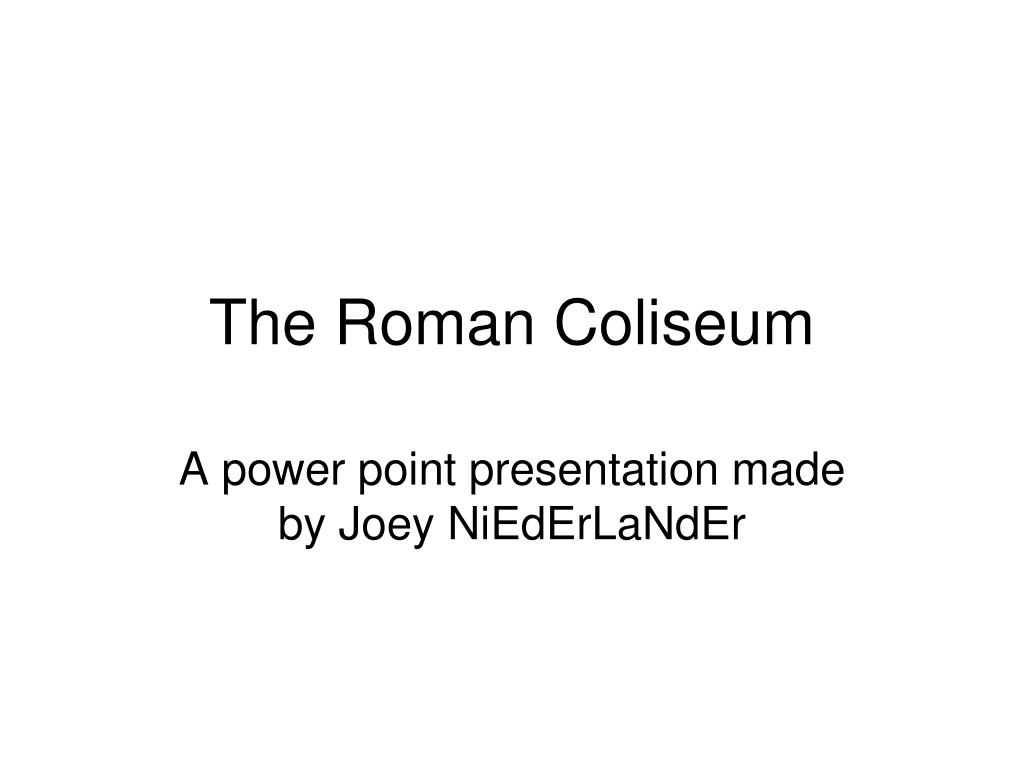




![Read⚡ebook✔[PDF] Blood of the Provinces: The Roman Auxila and the Making of Pro](/thumb/20539/read-ebook-pdf-blood-of-the-provinces-the-roman-auxila-and-the-making-of-pro.jpg)
![READ⚡[PDF]✔ European Mail Armour: Ringed Battle Shirts from the Iron Age, Roman](/thumb/20552/read-pdf-european-mail-armour-ringed-battle-shirts-from-the-iron-age-roman.jpg)





